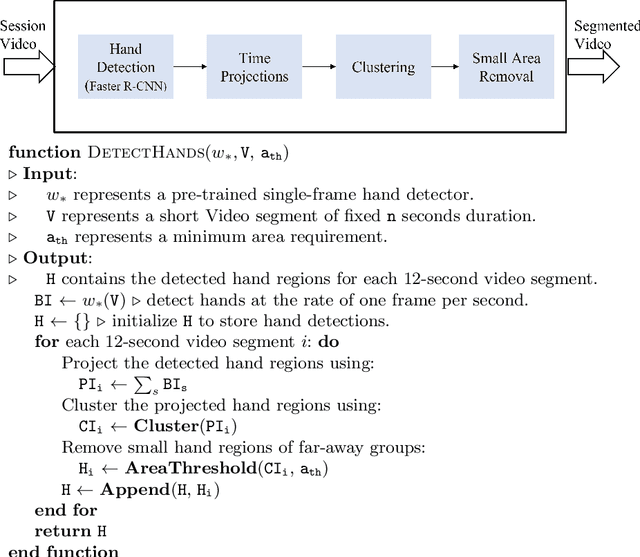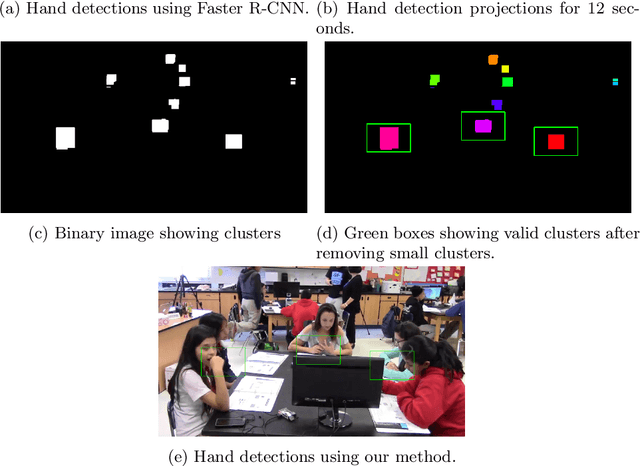Sravani Teeparthi
Fast Low-parameter Video Activity Localization in Collaborative Learning Environments
Mar 02, 2024Abstract:Research on video activity detection has primarily focused on identifying well-defined human activities in short video segments. The majority of the research on video activity recognition is focused on the development of large parameter systems that require training on large video datasets. This paper develops a low-parameter, modular system with rapid inferencing capabilities that can be trained entirely on limited datasets without requiring transfer learning from large-parameter systems. The system can accurately detect and associate specific activities with the students who perform the activities in real-life classroom videos. Additionally, the paper develops an interactive web-based application to visualize human activity maps over long real-life classroom videos.
Fast Hand Detection in Collaborative Learning Environments
Oct 13, 2021



Abstract:Long-term object detection requires the integration of frame-based results over several seconds. For non-deformable objects, long-term detection is often addressed using object detection followed by video tracking. Unfortunately, tracking is inapplicable to objects that undergo dramatic changes in appearance from frame to frame. As a related example, we study hand detection over long video recordings in collaborative learning environments. More specifically, we develop long-term hand detection methods that can deal with partial occlusions and dramatic changes in appearance. Our approach integrates object-detection, followed by time projections, clustering, and small region removal to provide effective hand detection over long videos. The hand detector achieved average precision (AP) of 72% at 0.5 intersection over union (IoU). The detection results were improved to 81% by using our optimized approach for data augmentation. The method runs at 4.7x the real-time with AP of 81% at 0.5 intersection over the union. Our method reduced the number of false-positive hand detections by 80% by improving IoU ratios from 0.2 to 0.5. The overall hand detection system runs at 4x real-time.
Long Term Object Detection and Tracking in Collaborative Learning Environments
Jun 02, 2021



Abstract:Human activity recognition in videos is a challenging problem that has drawn a lot of interest, particularly when the goal requires the analysis of a large video database. AOLME project provides a collaborative learning environment for middle school students to explore mathematics, computer science, and engineering by processing digital images and videos. As part of this project, around 2200 hours of video data was collected for analysis. Because of the size of the dataset, it is hard to analyze all the videos of the dataset manually. Thus, there is a huge need for reliable computer-based methods that can detect activities of interest. My thesis is focused on the development of accurate methods for detecting and tracking objects in long videos. All the models are validated on videos from 7 different sessions, ranging from 45 minutes to 90 minutes. The keyboard detector achieved a very high average precision (AP) of 92% at 0.5 intersection over union (IoU). Furthermore, a combined system of the detector with a fast tracker KCF (159fps) was developed so that the algorithm runs significantly faster without sacrificing accuracy. For a video of 23 minutes having resolution 858X480 @ 30 fps, the detection alone runs at 4.7Xthe real-time, and the combined algorithm runs at 21Xthe real-time for an average IoU of 0.84 and 0.82, respectively. The hand detector achieved average precision (AP) of 72% at 0.5 IoU. The detection results were improved to 81% using optimal data augmentation parameters. The hand detector runs at 4.7Xthe real-time with AP of 81% at 0.5 IoU. The hand detection method was integrated with projections and clustering for accurate proposal generation. This approach reduced the number of false-positive hand detections by 80%. The overall hand detection system runs at 4Xthe real-time, capturing all the activity regions of the current collaborative group.
 Add to Chrome
Add to Chrome Add to Firefox
Add to Firefox Add to Edge
Add to Edge